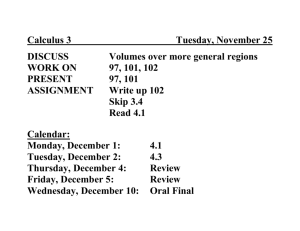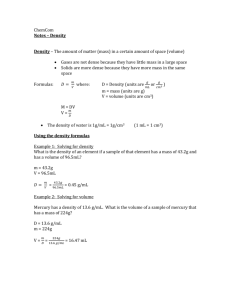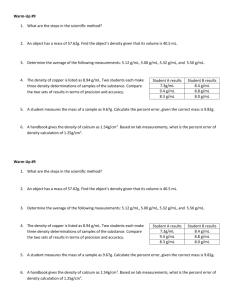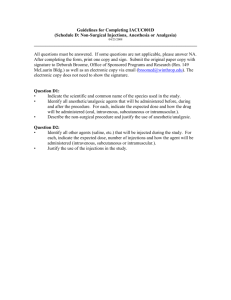Guidelines for the Administration of Substances, Including Routes
advertisement
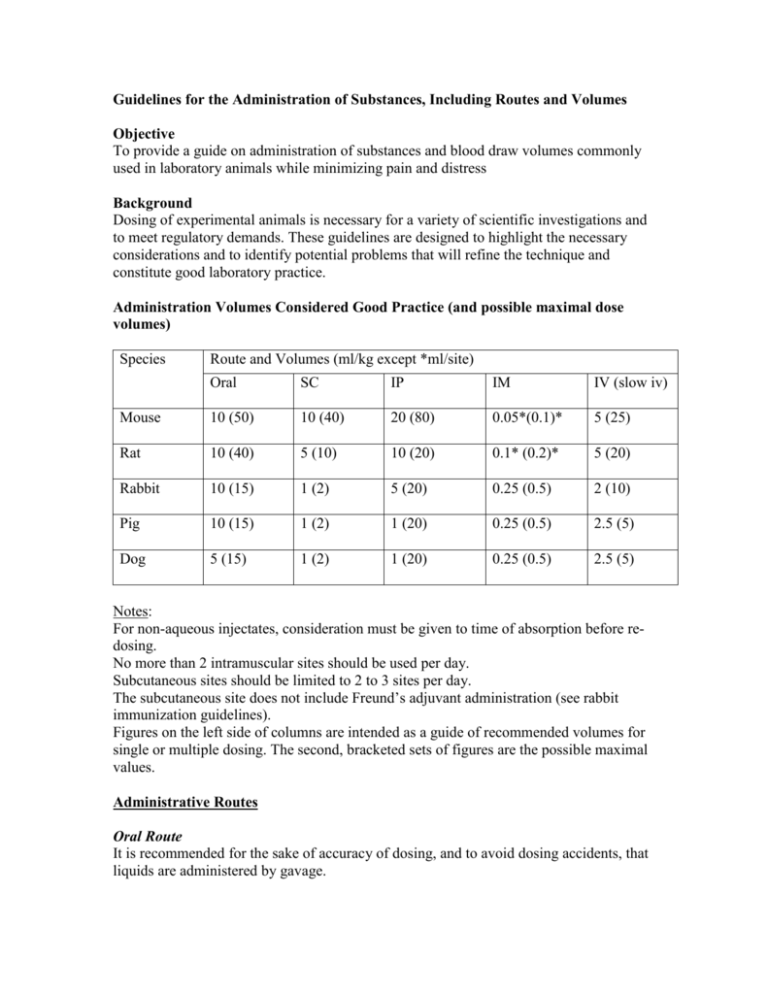
Guidelines for the Administration of Substances, Including Routes and Volumes Objective To provide a guide on administration of substances and blood draw volumes commonly used in laboratory animals while minimizing pain and distress Background Dosing of experimental animals is necessary for a variety of scientific investigations and to meet regulatory demands. These guidelines are designed to highlight the necessary considerations and to identify potential problems that will refine the technique and constitute good laboratory practice. Administration Volumes Considered Good Practice (and possible maximal dose volumes) Species Route and Volumes (ml/kg except *ml/site) Oral SC IP IM IV (slow iv) Mouse 10 (50) 10 (40) 20 (80) 0.05*(0.1)* 5 (25) Rat 10 (40) 5 (10) 10 (20) 0.1* (0.2)* 5 (20) Rabbit 10 (15) 1 (2) 5 (20) 0.25 (0.5) 2 (10) Pig 10 (15) 1 (2) 1 (20) 0.25 (0.5) 2.5 (5) Dog 5 (15) 1 (2) 1 (20) 0.25 (0.5) 2.5 (5) Notes: For non-aqueous injectates, consideration must be given to time of absorption before redosing. No more than 2 intramuscular sites should be used per day. Subcutaneous sites should be limited to 2 to 3 sites per day. The subcutaneous site does not include Freund’s adjuvant administration (see rabbit immunization guidelines). Figures on the left side of columns are intended as a guide of recommended volumes for single or multiple dosing. The second, bracketed sets of figures are the possible maximal values. Administrative Routes Oral Route It is recommended for the sake of accuracy of dosing, and to avoid dosing accidents, that liquids are administered by gavage. Formulations in pellet diet or in water can be custom made, but the investigator must check for palatability. Rodents cannot be fed powdered diet for prolonged periods (over 2 weeks) as their teeth will grow continuously and mal-occlusion will occur. Some compounds can be formulated into small jelly cubes Parenteral Routes The dose volume used, stability of the formulation before and after administration, the pH (4.5-8.0), viscosity, osmolality, buffering capacity, sterility and biocompatibility of the formulation are all factors to consider. Contaminated substances can cause infection and irritation at site of injection and can lead to self mutilation and even death The smallest needle size should be used taking into account the dose volume, viscosity of injection material, speed of injection and species. Volume and frequency of administration should be kept to a minimum. Warm substance to room or body temperature immediately before administration Subcutaneous This route is frequently used. The rate and extent of absorption depend on formulation. Intraperitoneal This route is used infrequently for multiple dose studies because of possible complications. There is a possibility of injecting into the intestinal tract and irritant materials may cause peritonitis. Intramuscular Intramuscular injections may be painful, because muscle fibers are necessarily placed under tension by the injected material. Sites need to be chosen to minimize the possibility of nerve damage. Sites should be rotated for multiple dose studies. A distinction needs to be made between aqueous and oily formulations (speed of absorption, oily formulations likely to remain as a depot for > 24 hours). With multiple dose studies there is a need to consider the occurrence of inflammation and its sequel. Intravenous administration For this route, distinctions are made between bolus injection, slow intravenous injection, and intravenous infusion. Bolus injection: In most studies using the intravenous route the test substance is given over a short period, approximately 1 minute. Such relatively rapid injections require the test substance to be compatible with blood and not too viscous. When large volumes are required to be given the injection material should be warmed to body temperature. The rate of injection is an important factor in intravenous administration and it is suggested that, for rodents, the rate should not exceed 3 ml/min. Intradermal This site is typically used for assessment of immune, inflammatory, or sensitization response. Material may be formulated with an adjuvant. Volumes of 0.05 to 0.1 ml can be used dependent upon the thickness of skin. Vehicles for Administration Vehicles should ideally be biologically inert, have no effect on the biophysical properties of the compound and have no toxic effects on the animals. Compounds include aqueous isotonic solutions, buffered solutions, cosolvent systems, suspensions and oils. For non-aqueous injections consideration should be given for time of absorption before re-dosing. Whenever possible use sterile medical grade compounds with valid expiration date to avoid confounding side effects. Needle Sizes for Administration of Substances Species Intradermal Subcutaneous Intramuscular Mouse 27G 25G 27G Rat 27G 25G 25G Guineapig 25G 23-25G 25G Hamster 25G 25G 25G Rabbit 25G 21-25G 25G Dog 25G 21-23G 21-23G Sheep 25G 19-23G 21G Pig 25G 19-21G 19-21G Itravenous 26-28G 25-27G 25-27G 25-27G 23-25G 21-25G 19-21G 19-23G Intraperitoneal 25-27G 23-25G 23-25G 23-25G 21-23G 21-23G 19-21G Reference: 1. A good practice guide to the administration of substances and removal of blood, including routes and volumes. Karl-Heinz Diehl, Robin Hull, David Morton, Rudolf Pfister, Yvon Rabemampianina, David Smith, Jean-Marc Vidal, Cor Van De Vorstenbosch . J Appl Toxicol 21 15-23, 2001. 2. Refining procedures for the administration of substances. Report of the BVAAWF/ FRAME/ RSPCA/ UFAW joint working group on refinement. D.B. Mortom, M. Jennings, A. Beckwell, R. Ewbank, C. Godfrey, B. Holgayte, I. Inglis, R. James, C. Page, I. Sharman, R. Verschoyle, L. Westall and A.B. Wilson. Laboratory Animals 35, 1-41, 2001.
